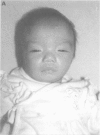Abstract
Chromosomal translocations affecting the 6p24 region have been associated with orofacial clefting. Here we present a female patient with cleft palate, severe growth retardation, developmental delay, frontal bossing, hypertelorism, antimongoloid slant, bilateral ptosis, flat nasal bridge, hypoplastic nasal alae, protruding upper lip, microretrognathia, bilateral, low set, and posteriorly rotated ears, bilateral microtia, narrow ear canals, short neck, and a karyotype of 46,XX,t(6;9)(p24;p23). The translocation chromosomes were analysed in detail by FISH and the 6p24 breakpoint was mapped within 50-500 kb of other breakpoints associated with orofacial clefting, in agreement with the assignment of such a locus in 6p24. The chromosome 9 translocation breakpoint was identified to be between D9S156 and D9S157 in 9p23-p22, a region implicated in the 9p deletion syndrome.
Full text
PDF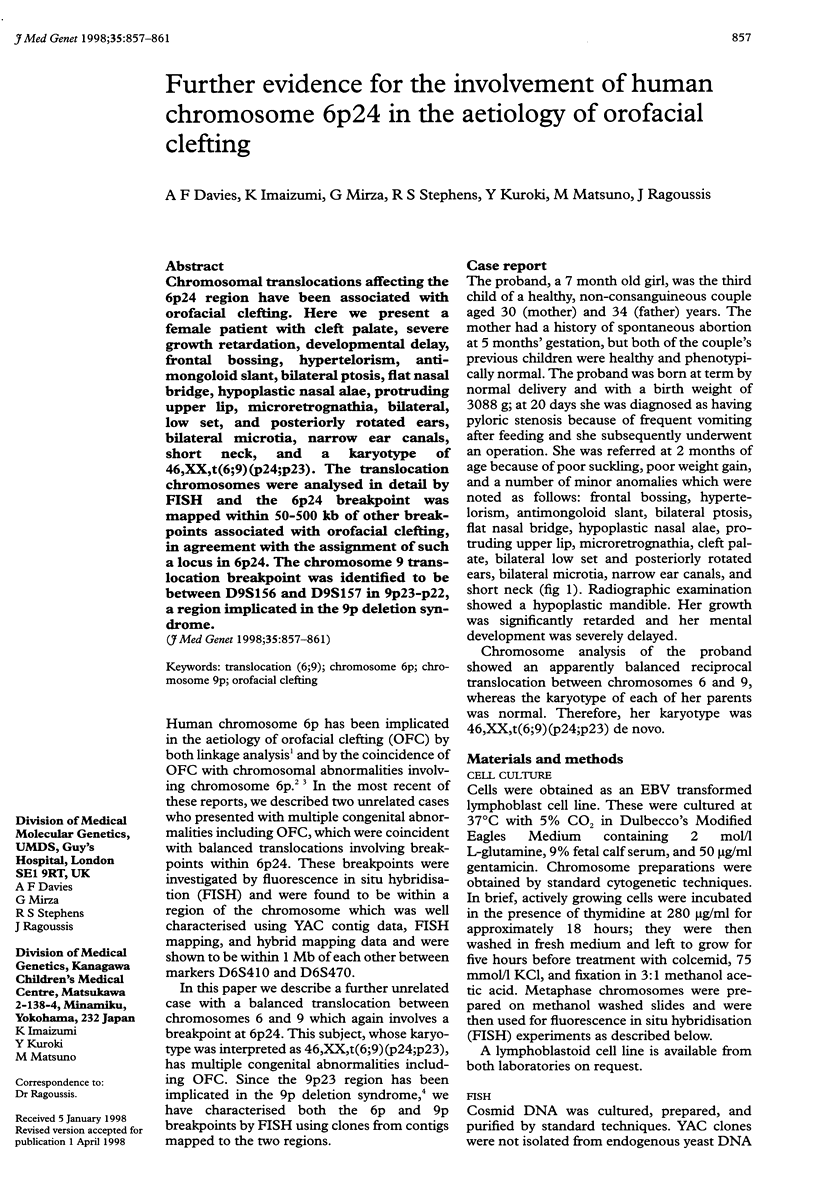
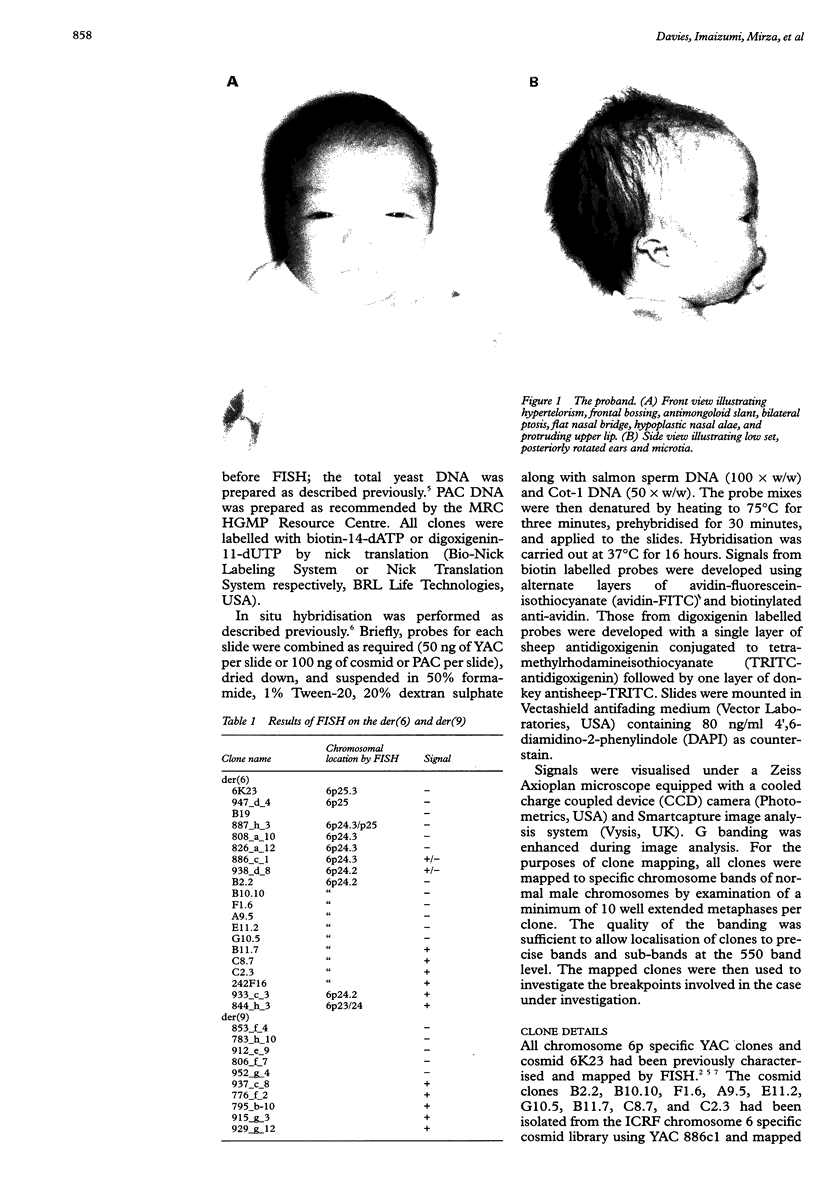
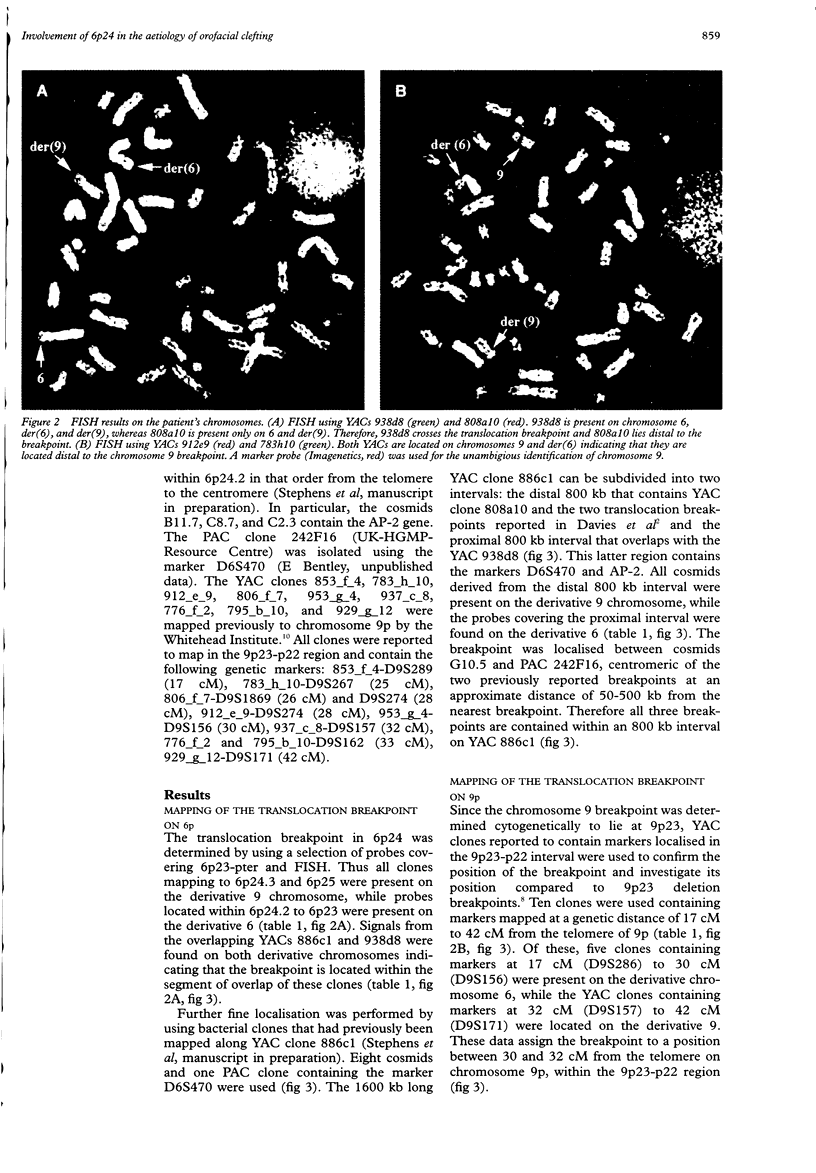
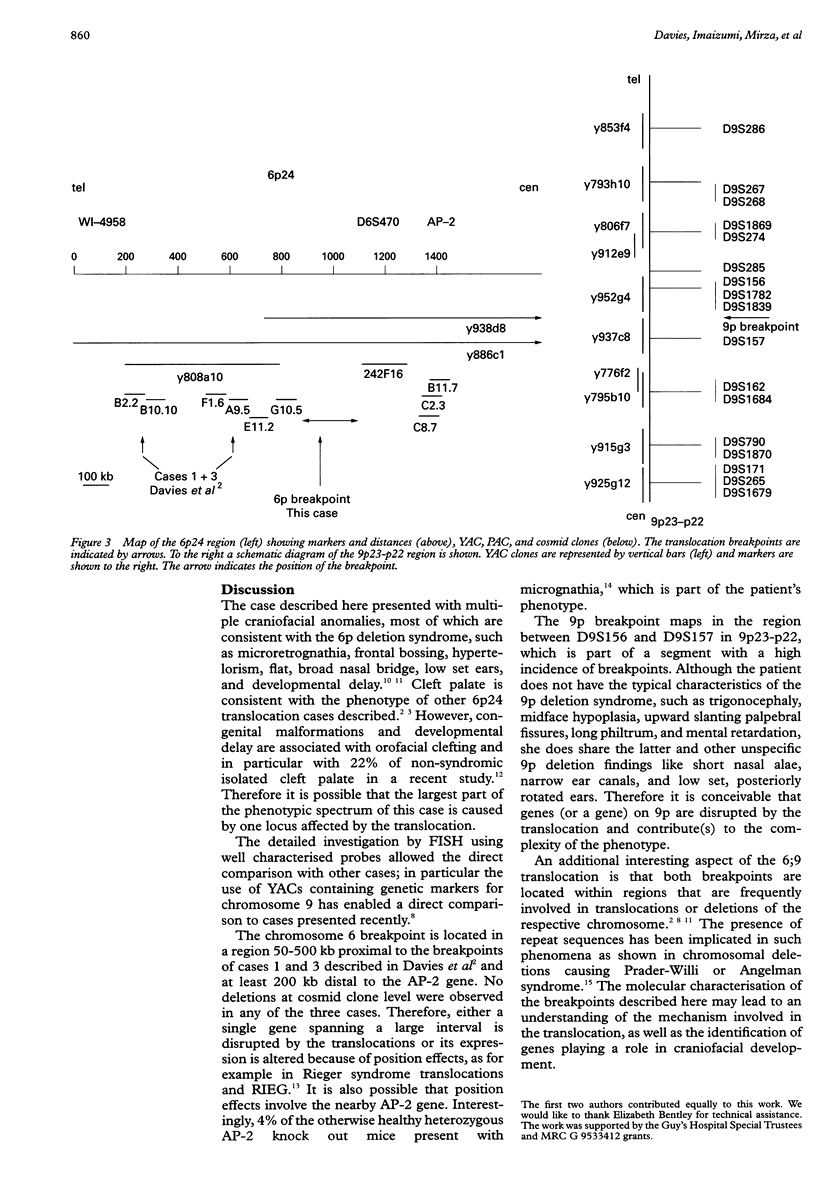
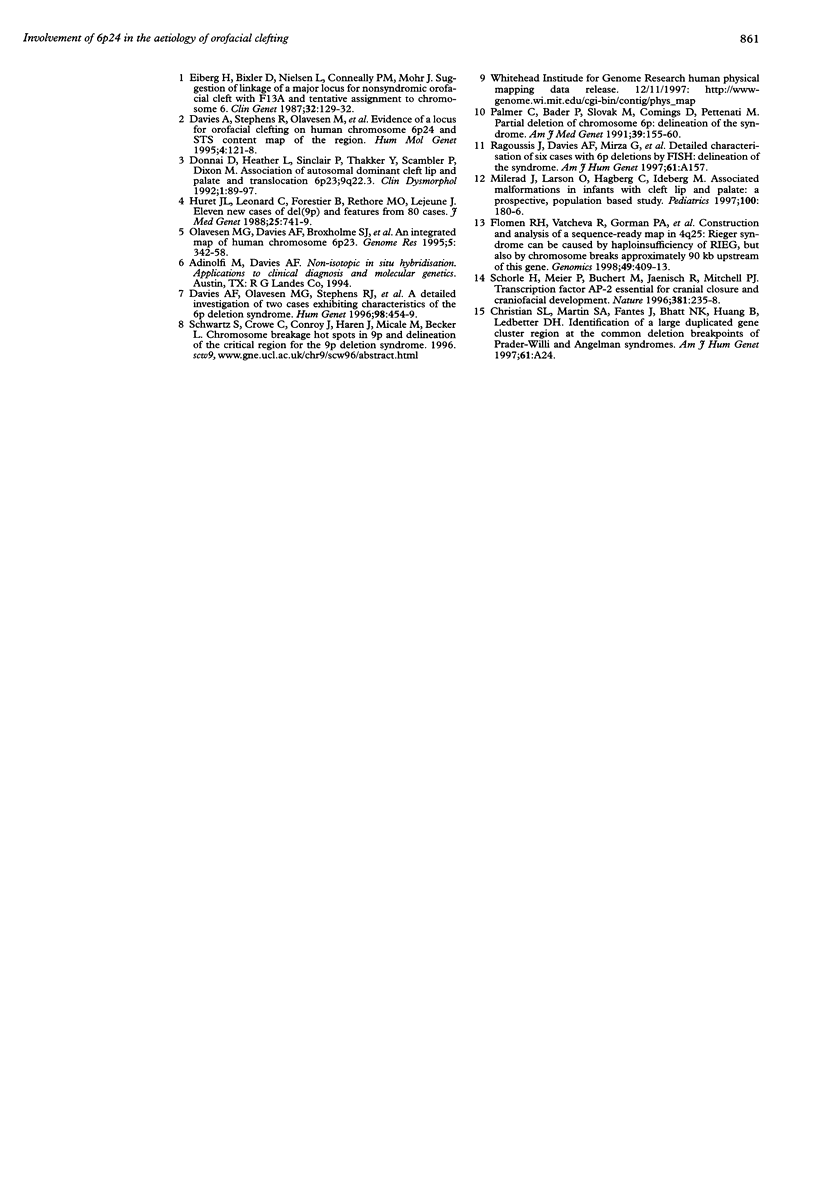
Images in this article
Selected References
These references are in PubMed. This may not be the complete list of references from this article.
- Davies A. F., Olavesen M. G., Stephens R. J., Davidson R., Delneste D., Van Regemorter N., Vamos E., Flinter F., Abusaad I., Ragoussis J. A detailed investigation of two cases exhibiting characteristics of the 6p deletion syndrome. Hum Genet. 1996 Oct;98(4):454–459. doi: 10.1007/s004390050239. [DOI] [PubMed] [Google Scholar]
- Davies A. F., Stephens R. J., Olavesen M. G., Heather L., Dixon M. J., Magee A., Flinter F., Ragoussis J. Evidence of a locus for orofacial clefting on human chromosome 6p24 and STS content map of the region. Hum Mol Genet. 1995 Jan;4(1):121–128. doi: 10.1093/hmg/4.1.121. [DOI] [PubMed] [Google Scholar]
- Donnai D., Heather L. J., Sinclair P., Thakker Y., Scambler P. J., Dixon M. J. Association of autosomal dominant cleft lip and palate and translocation 6p23;9q22.3. Clin Dysmorphol. 1992 Apr;1(2):89–97. [PubMed] [Google Scholar]
- Eiberg H., Bixler D., Nielsen L. S., Conneally P. M., Mohr J. Suggestion of linkage of a major locus for nonsyndromic orofacial cleft with F13A and tentative assignment to chromosome 6. Clin Genet. 1987 Aug;32(2):129–132. doi: 10.1111/j.1399-0004.1987.tb03340.x. [DOI] [PubMed] [Google Scholar]
- Flomen R. H., Vatcheva R., Gorman P. A., Baptista P. R., Groet J., Barisić I., Ligutic I., Nizetić D. Construction and analysis of a sequence-ready map in 4q25: Rieger syndrome can be caused by haploinsufficiency of RIEG, but also by chromosome breaks approximately 90 kb upstream of this gene. Genomics. 1998 Feb 1;47(3):409–413. doi: 10.1006/geno.1997.5127. [DOI] [PubMed] [Google Scholar]
- Huret J. L., Leonard C., Forestier B., Rethoré M. O., Lejeune J. Eleven new cases of del(9p) and features from 80 cases. J Med Genet. 1988 Nov;25(11):741–749. doi: 10.1136/jmg.25.11.741. [DOI] [PMC free article] [PubMed] [Google Scholar]
- Milerad J., Larson O., PhD D., Hagberg C., Ideberg M. Associated malformations in infants with cleft lip and palate: a prospective, population-based study. Pediatrics. 1997 Aug;100(2 Pt 1):180–186. doi: 10.1542/peds.100.2.180. [DOI] [PubMed] [Google Scholar]
- Olavesen M. G., Davies A. F., Broxholme S. J., Wixon J. L., Senger G., Nizetic D., Campbell R. D., Ragoussis J. An integrated map of human chromosome 6p23. Genome Res. 1995 Nov;5(4):342–358. doi: 10.1101/gr.5.4.342. [DOI] [PubMed] [Google Scholar]
- Palmer C. G., Bader P., Slovak M. L., Comings D. E., Pettenati M. J. Partial deletion of chromosome 6p: delineation of the syndrome. Am J Med Genet. 1991 May 1;39(2):155–160. doi: 10.1002/ajmg.1320390208. [DOI] [PubMed] [Google Scholar]
- Schorle H., Meier P., Buchert M., Jaenisch R., Mitchell P. J. Transcription factor AP-2 essential for cranial closure and craniofacial development. Nature. 1996 May 16;381(6579):235–238. doi: 10.1038/381235a0. [DOI] [PubMed] [Google Scholar]
- Weiss J. O., Kozma C., Lapham E. V. Whom would you trust with your genetic information? Am J Hum Genet. 1997 Oct;61(4):A24–A24. [PubMed] [Google Scholar]



